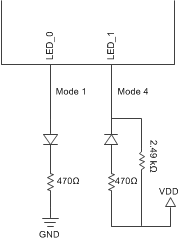ZHCSNO0B April 2021 – November 2021 DP83561-SP
PRODUCTION DATA
- 1 特性
- 2 应用
- 3 说明
- 4 Revision History
- 5 Pin Configuration and Functions
- 6 Specifications
-
7 Detailed Description
- 7.1 Overview
- 7.2 Functional Block Diagram
- 7.3
Feature Description
- 7.3.1 Copper Ethernet
- 7.3.2 MAC Interfaces
- 7.3.3
Auto-Negotiation
- 7.3.3.1 Speed and Duplex Selection - Priority Resolution
- 7.3.3.2 Master and Slave Resolution
- 7.3.3.3 Pause and Asymmetrical Pause Resolution
- 7.3.3.4 Next Page Support
- 7.3.3.5 Parallel Detection
- 7.3.3.6 Restart Auto-Negotiation
- 7.3.3.7 Enabling Auto-Negotiation Through Software
- 7.3.3.8 Auto-Negotiation Complete Time
- 7.3.3.9 Auto-MDIX Resolution
- 7.3.4 Speed Optimization
- 7.3.5 Radiation Performance
- 7.3.6 WoL (Wake-on-LAN) Packet Detection
- 7.3.7 Start of Frame Detect for IEEE 1588 Time Stamp
- 7.3.8 Cable Diagnostics
- 7.3.9 Clock Output
- 7.4 Device Functional Modes
- 7.5
Programming
- 7.5.1
Serial Management Interface
- 7.5.1.1
Extended Address Space Access
- 7.5.1.1.1 Write Address Operation
- 7.5.1.1.2 Read Address Operation
- 7.5.1.1.3 Write (No Post Increment) Operation
- 7.5.1.1.4 Read (No Post Increment) Operation
- 7.5.1.1.5 Write (Post Increment) Operation
- 7.5.1.1.6 Read (Post Increment) Operation
- 7.5.1.1.7 Example of Read Operation Using Indirect Register Access
- 7.5.1.1.8 Example of Write Operation Using Indirect Register Access
- 7.5.1.1
Extended Address Space Access
- 7.5.2 Interrupt
- 7.5.3 BIST Configuration
- 7.5.4 Strap Configuration
- 7.5.5 LED Configuration
- 7.5.6 LED Operation From 1.8-V I/O VDD Supply
- 7.5.7 Reset Operation
- 7.5.1
Serial Management Interface
- 7.6 Register Maps
- 8 Application and Implementation
- 9 Power Supply Recommendations
- 10Layout
- 11Device and Documentation Support
- 12Mechanical, Packaging, and Orderable Information
7.5.5 LED Configuration
The DP83561-SP supports four configurable Light Emitting Diode (LED) pins: LED_0, LED_1, LED_2, and RXD7/GPIO. Several functions can be multiplexed onto the LEDs for different modes of operation. The LED operation mode can be selected using the LEDCR1 register (address 0x0018).
Because the LED output pins are also used as straps, the external components required for strapping and LED usage must be considered to avoid contention. Specifically, when the LED outputs are used to drive LEDs directly, the active state of each output driver is dependent on the logic level sampled by the corresponding AN input upon power up or reset.
If a given strap input is resistively pulled low then the corresponding output is configured as an active high driver. In the context of the 4-level straps, this occurs for modes 1, 2, and 3. Conversely, if a given strap input is resistively pulled high, then the corresponding output is configured as an active low driver. In the context of the 4-level straps, this occurs only for mode 4.
Refer to Figure 7-15 for an example of strap connections to external components. In this example, the strapping results in Mode 1 for LED_0 and Mode 4 for LED_1.
The adaptive nature of the LED outputs helps to simplify potential implementation issues of these dual-purpose pins.
 Figure 7-15 Example Strap Connections
Figure 7-15 Example Strap Connections